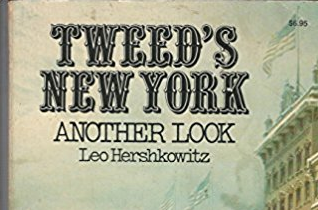We were saddened to learn of the recent passing of a celebrated New York historian and professor, Dr. Leo Hershkowitz.
A New Yorker through and through, Dr. Hershkowitz grew up in the East Bronx, attended Queens College thanks to the G.I. Bill, and received his Ph.D. from New York University.
He then went on to become a tenured professor of history at Queens College and made many significant contributions to the historical understanding of New York City.
He will be remembered by his students, colleagues and those close to him for his deep humanity, but it was his appreciation for archival research and the many discoveries it yielded that will be his lasting legacy in the field of history.
A genealogist's historian
The New York Times, which profiled Professor Hershkowitz nearly thirty years ago, noted this approach to constructing history:
"[Dr. Hershkowitz] has made it his business to scavenge through mountains of original documents to get the goods on the city he loves. He delights in donning a mask to sift through dusty, musty scraps of paper. He has been known to chase dump trucks en route to shredding plants... Dr. Hershkowitz amasses roomfuls of randomness -whether municipal, state or even colonial records - on the pure chance he'll find something new."
"...[his] belief is that history is an iceberg. Nine-tenths lurks beneath the surface, quickly and forever lost. What remains are heroes and comfortable ideologies. Mythologies, really. Books say a canal was built, but disclose nothing of the pain in men's backs."
Although everyone can appreciate the unique contributions this approach to historical work unearthed, genealogists will have a particular appreciation for his focus on original research.
Dr. Hershkowitz was sometimes critical of his peers, who he contended - according to the Times - were merely "re-telling stale stories" by working from abstracted or indexed materials and secondary sources. Indeed, as all genealogists know, working purely from derivative sources can be perilous.
A lasting legacy of historical discovery
This far-too-uncommon approach led to some truly astounding discoveries. In the 1970's, he dove into the New York City Comptroller's records and offered a revision of the history of infamous politician Boss Tweed.

factors Hershkowitz identified as contributing to the historical misunderstanding.
Here, he is depicted as a bullying schoolteacher, giving arithmetic lessons to the
city comptroller. More information about this cartoon at loc.gov
His resulting book, Tweed's New York: Another Look, argued that many previously unchallenged beliefs were historical illusions.
He suggested that contrary to the beliefs of academics and laymen alike, Tweed wasn't as powerful as he has been remembered, and that his alleged theft and corruption may also have been exaggerated.
According to Hershkowitz, Tweed was "never tried for or found guilty of graft or theft." Instead, he was "a paper tiger, a bench warmer" who served as a convenient villain and target of the press and anti-immigrant New York establishment.
A contemporary review of the work noted that Dr. Hershkowitz "is uniquely suited to defend his revolutionary theses. His concern for the preservation and maintenance of archival materials is well known, and he had the tenacity to read the records of Tweed's Era."
The list of discoveries made from the masses of records he rescued from destruction is truly too long to list, but they were numerous and most importantly, always original.
He made significant discoveries about the first Jews of New York, in particular by shedding more light on the life of one of New York's first prominent Jewish residents. He found that fifteenth-century resident Asser Levy was born in Lithuania - an important discovery about the earliest Jewish immigration to the colony.
Leo Hershkowitz lives on through his many contributions to our understanding of the history of New York City and serves as a perennial example of the amazing discoveries that can be made through working with primary sources.
